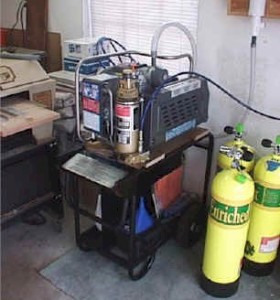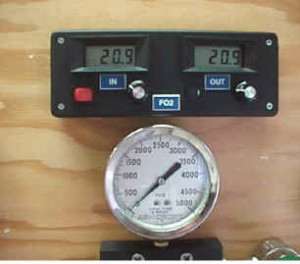Basic Nitrox Fill Station
It only takes up a 3 x 6 foot corner of the garage.
The components are:
1) Bauer Oceanus Compressor
2) Air and O2 Blender made from PVC
3) Homemade Oxygen Analyzers
4) Oxygen Tank (280 cf “H” tank is pictured, but I use a 330 cf “T” tank now)
5) Welding Regulator (modified)
6) Medical Regulator
7) Manifold, Whips, Gauges, Yokes, clock,
thermometer, and humidity gauge
Trimix Filling Station
Looks a lot like the Nitrox station above!
The brown tank supplies He to the Air and O2 blender through an additional hose a couple of inches below the O2 supply. The Atomox He analyzer is connected to the same medical regulator that supplies the downstream O2 analyzer.
Compressor
– Bauer Oceanus
– 220V/Single Phase (30 amp)
– 4.9 SCFM *
– Synthetic Oil
* Fills an empty AL80 in about 20 minutes.
Since tanks are rarely empty, the average is 4 AL80s per hour.
Air & O2 & He Blender
Oxygen, air, and Helium are mixed in a 2-foot section of 2 inch diameter PVC pipe.
O2 Flow Control
Note: I have replaced this regulator with a Radnor flow meter as seen below, but I am leaving this description in case someone would like to use this option.
This is a Victor welding regulator.
I installed a #77 orifice from a junk medical reg, but this would not give me enough flow. I drilled out the orifice using a #60 drill bit and replaced the original 120 psi gauge with a 30 psi gauge. The 30 psi gauge allows the needle to deflect to just over mid-scale at the flow rate required for 36% FO2.
Helium Flow Control
This is a a Radnor flow meter.
Unlike the Victor regulator above, which reads intermediate pressure, this is a true flow meter.
Oxygen Analyzers
 I made the analyzers from kits (Oxycheq.com), and mounted both of them in a single box.
I made the analyzers from kits (Oxycheq.com), and mounted both of them in a single box.
The analyzer on the left reads the Fraction of Oxygen (FO2) after the O2 and air are blended. The analyzer on the right reads the FO2 after the mix is compressed.
O2 Whip and Yokes.
I use two yokes:
1) The CGA 870 yoke is used to fill my emergency “D” Tanks
2) The Scuba yoke is used to fill a scuba tank that is also for emergency use.
Basic O2 Transfill Whip
(with a few suppliers and prices).
I only use the O2 whip for transfilling my Emergency O2 Tanks.
A Partial Pressure fill whip would need a good “Master” gauge in the proper range
Oil and Condensation Drain
There is a fair amount of pressure released when you drain the condensation from the compressor. This thing vents the air pressure while trapping the oil and water mist.
I spent $5000 on the Fill Station, but I’m still proud of this 0$ contraption!